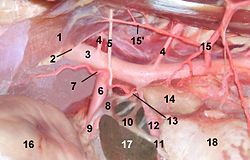Celiac_ganglia
Celiac ganglia
Two large masses of nerve tissue in the upper abdomen
The celiac ganglia or coeliac ganglia are two large irregularly shaped masses of nerve tissue in the upper abdomen. Part of the sympathetic subdivision of the autonomic nervous system (ANS), the two celiac ganglia are the largest ganglia in the ANS, and they innervate most of the digestive tract.
This article includes a list of general references, but it lacks sufficient corresponding inline citations. (June 2011) |
They have the appearance of lymph glands and are placed on either side of the midline in front of the crura of the diaphragm, close to the suprarenal glands (also called adrenal glands). The ganglion on the right side is placed behind the inferior vena cava.
They are sometimes referred to as the semilunar ganglia or the solar ganglia.

